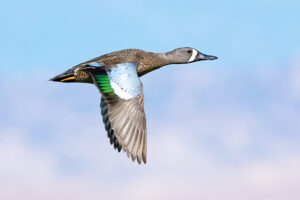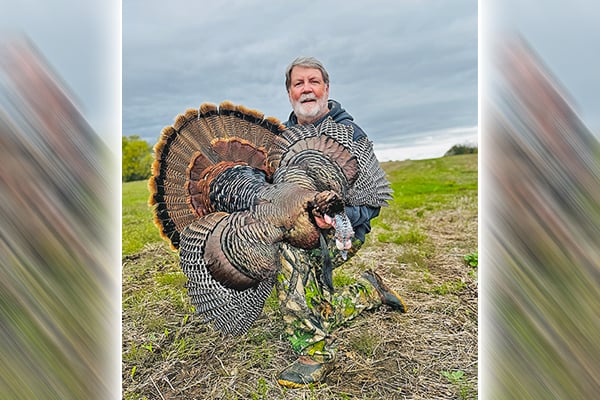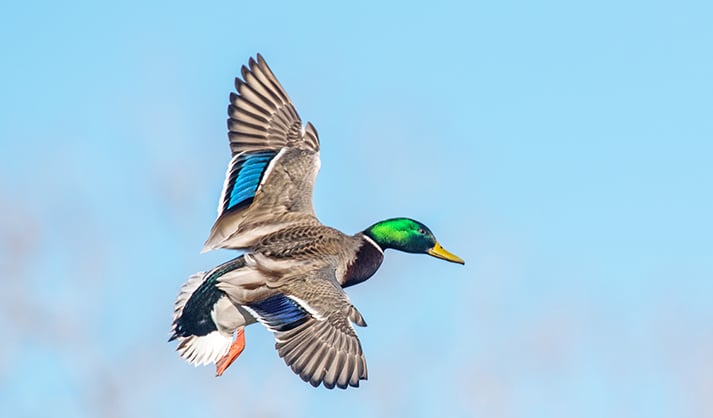New York’s volunteer duck banders were ‘pioneers’ for waterfowl conservation – Outdoor News
Many outdoor enthusiasts are familiar with the United States Geological Survey (USGS) metal leg bands that are placed on many species of birds to collect data about their lives. Ducks are one of the most commonly banded birds in North America.
The New York State Department of Environmental Conservation (DEC) has banded waterfowl in partnership with USGS, United States Fish and Wildlife Service, and many volunteers since 1935. Each year, DEC staff, the USFWS, and University researchers working with DEC, band approximately 8,000 ducks, geese, and other migratory game birds across New York State.
The bulk of these birds are Canada geese, wood ducks, mallards, and American black ducks. Migratory birds are banded for many important management and research needs, but all of it relies on volunteers; especially those who encounter a marked bird after it has been banded.
Banding ducks and geese provides important information on migration corridors, survival rates (what percentage of the birds survive each year), harvest rates (the percentage of the birds that are harvested by hunters), and age ratios (young of the year per adult bird). The primary use of these data are to examine the changes in hunting pressure encountered by unique populations of each species of waterfowl.
MORE COVERAGE FROM NEW YORK OUTDOOR NEWS:
New York 16-year-old lives up to his name in winning trapshooting national championship
Mike Raykovicz: Know the difference between ‘magnum’ and ‘chilled’ lead shot
Tips to get your boat ready for New York’s open water season
For example, when Canada Goose bands are reported, DEC can determine if the geese are from resident populations that never migrate and breed locally, or from the less abundant goose populations that breed in Canada and winter in the Chesapeake.
Finally, survival rates for breeding and wintering populations of waterfowl in the Atlantic Flyway are an important piece of information that DEC gets when banded waterfowl are recaptured or harvested, and the band is reported to DEC or the USFWS.
Collectively, 3.4 million ducks and geese have been banded by the states and provinces along the Atlantic Flyway since 1965. Waterfowl are banded in two distinct periods, prior to the hunting season (also known as “pre-season banding”) and during the winter (“post-season banding”).
The goal for duck and Canada goose banding in the pre-season period before migration and hunting season begins is to capture a representative sample of the species that nest in New York in large numbers: Canada geese, mallards, wood ducks, and American black ducks. In general, over 2,500 ducks and 3,500 Canada geese are banded prior to migration and hunting seasons.
The second period is winter banding. Winter banding programs exist to capture and tag species of ducks that spend the winter in New York which to them, is “south.” Some of the ducks banded here, such as black ducks and mallards, nest in far northern areas including areas in northern Canadian prairie provinces and potholes, northern woodlands, and maritime provinces.
By banding them in the winter, it gives managers another datapoint to refine and improve the accuracy and precision of survival estimates. New York is uniquely positioned in that it boasts not only a large breeding population of many duck species, but also winters a large number of ducks, including diving ducks like redheads, scaup, and canvasbacks.

New York has the benefit of two Great Lakes, the Niagara River, and the Finger Lakes which are deep enough, fast enough, or have other features that keep water open throughout the frigid winter months. This open water is attractive to enormous flocks of ducks which spend most of their lives in water, and feed on shellfish and mollusks, submerged aquatic vegetation, and the abundant fish populations in these waterbodies.
Historically, winter waterfowl flocks consisted of “diving duck” species that in general, contained very limited numbers of banded individuals because up until 1947, virtually no projects had banded a significant number of these birds.
Then, in the mid-1950’s, and 1960’s a few sportsmen who believed in the value of waterfowl banding contacted the Conservation Department (the precursor of the DEC) and expressed interest in banding waterfowl in the winter. They were waterfowl hunters who were involved in their local conservation club chapters and were ready to participate in any way they could to help band ducks.
Duck banding became a passion of theirs, and these dedicated outdoorsmen spent decades of their lives banding ducks every winter for 60 years. Two of these duck banders are Ernie Pitman and Mike Rosing, who involved their friends and family in the endeavor.
Although DEC no longer utilizes volunteers for banding operations, the contributions of these pioneers was hugely important.
The Pitmans – Finger Lakes Duck Banders
As Eric Pitman recalled in a recent conversation with DEC, it all started in the late 1960s when the New York State Conservation Department contacted his father, Ernie Pitman, asking if he would be interested in banding ducks on two of the Finger Lakes. He said “Sure.” Soon, there was a banding site established at Milliken Station on the east side of Cayuga Lake, and one on the west side of Skaneateles Lake.
Ernie would soon be joined by his oldest son Chris in helping with the banding. In the early ‘70s Ernie “retired” and Chris gladly took over as the lead bander. Soon Chris realized he needed help to band once a day on Cayuga and twice a day on Skaneateles.
The call went out to his younger brother, Eric, asking if he would help. Chris worked the 3-to-11 pm shift at New Process Gear in Syracuse so he had the morning shift on the duck trap. Eric on the other hand worked an 8-to-5 job, so he had the night shift. This meant sub-freezing temperatures for many nights, armed with a lantern, a net, crate and bands.
One couldn’t put bands on the birds and record the information with gloves on.
In the early ‘80s they stopped banding on Cayuga and concentrated on Skaneateles. Black ducks, mallards, bluebills (scaup), buffleheads and whistlers (goldeneye) were often in the trap during their three month ‘season’ of banding.
In 2003, they started banding in front of Eric’s house on the west side of Skaneateles Lake. The prominent “catch of the day” were blacks and mallards. When it got really cold Redheads would appear for a day or two. They were really “pigs” when they found the bait, recalled Eric. When that happened, it would not be uncommon to band 100 to 200 in that one-to-two-day period.
The banding eventually got easier. One very cold night, Eric pulled the sled with a crate full of birds from the water’s edge to the lee side of his house. He knelt down to band, took off his gloves, and the wet ducks and the cold temperatures resulted in severe discomfort.
His hands were “freakin’ freezin’” and two feet to his right was the warmth of his house. At that point, the crate was lifted off the sled, and moved inside his house, where the birds were released one at a time through the sliding glass doors. From then on, that’s how it was done.
Chris Pitman unfortunately passed in,2024 from cancer. Eric Pitman reached out to DEC to see if it would be okay if he banded one more day in memory of his brother. So, one day in January of 2025, Eric Pitman joined a DEC banding crew and banded for the last time.
The catch: six mallards, two black ducks and one pintail: the only pintail Eric remembers the Pitman’s ever banding. This seemed a fitting end to the legacy of the Pitman’s banding on the Finger Lakes for the last 60 years. In those 60 years Eric thinks his father, brother, and himself banded over 20,000 ducks. DEC now bands ducks on the shoreline in front of Eric’s house on Skaneateles Lake.
Mike Rosing – Lake Erie Duck Bander
Mike Rosing, one of the founding members of the Finger Lakes and Western NY Waterfowl Association in 1962, is now 84 years young and living at home in Dunkirk, where he trapped and banded waterfowl for 55 years. Mike is a lifetime member of the Northern Chautauqua Conservation Club in Dunkirk (a.k.a. the “Con Club”), which he joined at age 14.
It was 1955 when club member Bob Withington and club secretary, Frank Kuhn at ages 42 and 50, asked young Mike to help with their project of banding diving ducks in Dunkirk Harbor.
Sheltered somewhat from Lake Erie’s winter storms by breakwaters, the water of the inner harbor was kept from freezing solid by warm water discharge from the Niagara Mohawk power plant that began operation in 1950. In winter, when Lake Erie was frozen solid, the open water attracted huge flocks of migrating and over-wintering diving ducks, which did not go unnoticed by the Con Club members.
These flocks consisted of redheads, canvasback, ringnecks, scaup, goldeneye, bufflehead, and long-tailed ducks, along with many black ducks.
In 1954. when the members of the Con Club learned that due to capture difficulty, there were few banded diving ducks in North America, they reached out to the New York Conservation Department, which issued a joint US Fish and Wildlife Service/Conservation Department license to the secretary, Frank Kuhn.
The Con Club erected a diving duck “swim-in” trap baited with corn in the near shore area of the club and began banding in January of 1955. That winter, nearly 1,000 ducks were banded, which was more than all other banding stations in the state in the previous six years.
Mike Rosing loved to band ducks and continued helping Bob and Frank until he joined the Navy at age 18. When he returned from service, he resumed duck banding in 1962 and continued until 2016 when Niagara Mohawk closed the plant and winter temperatures again froze the harbor solid.
Mike recalled, “I went down there and helped the older guys doing it, and then one guy moved out of town and the other guy was a little too old to keep doing it. I did it until I went to the Navy, and then did it again until the plant shut down.”
The total number of ducks banded at the Dunkirk station totaled 19,903 when the project concluded. Through the years, many members of the Northern Chautauqua Conservation Club assisted Mike with the trapping and banding efforts throughout the winter banding period, most notably his son Fred.
The cost of this was a few bales of wire or bags of corn, as everyone volunteered their time, and the Con Club, or DEC supplied the corn.
When someone bands thousands of ducks, one might wonder: do they have a favorite? Mike offered this: “I liked banding black ducks or divers like bluebills. But it didn’t really matter. I just liked banding.”
Mike reiterated, “I just kept doing it because it was something I liked to do, and my son did it with me until he went in the Marine Corps, but he liked it as much as me. I’d set the trap in the morning before I went to work at National Fuel right down the road, and check it when I got home. I would band again just before nightfall and tip the trap over until the next morning so no birds would get caught overnight.”
Memories of trapping in the winter inevitably involve those days that were spectacularly cold, and Mike recalled that as well, “Duck banding, well it was always cold and there was a lot of ice. But we enjoyed it, and did a lot of banding, but it got to be too much after a while, and when the plant shut down, that was it for sure.”
All the duck banders from that time knew each other, and Mike knew them through the Finger Lakes and Western NY Waterfowl Association, or Ducks Unlimited. There was Chris Pitman and his sons on the Finger Lakes, Jerry Farrell in Lewiston on the lower Niagara River, and Mike’s good friend John Daniels.
He recalled, “John had his own stations around Grand Island where he’d band on the upper Niagara, but he liked to come down and hunt here or help us band. He used to work at the plant (Niagara Mohawk), but then stop by to band, and come to the house for a cup of tea to warm up, then say, well, I better get back to work.”
They were waterfowl hunters as well as bander “We hunted on the breakwater; we didn’t often get a duck we had banded, but it was nice to get returns. I might have shot one or two ducks with bands, and they weren’t even our birds. We had a LOT of black ducks come in, in those days,” Mike said
It is important to recognize the contribution made by good waterfowlers and duck banders, now and forever. These people and many other volunteer banders made huge contributions to waterfowl conservation. We can only imagine the information gained from returns of waterfowl bands from their tens of thousands of banded ducks, and the data gathered while banding.
Perhaps Mike Rosing said it best when speaking about this: “I’m glad some people still remember what we did.”
Many of us do remember and are grateful for the tremendous base of waterfowl information these rare individuals established by spending their so-called ‘free’ time on long and cold, but satisfying, wonder-filled hours of trapping and banding waterfowl in New York.







